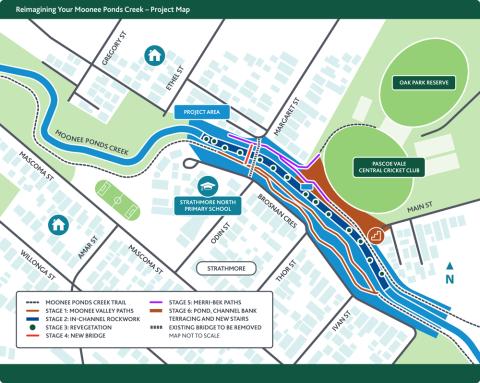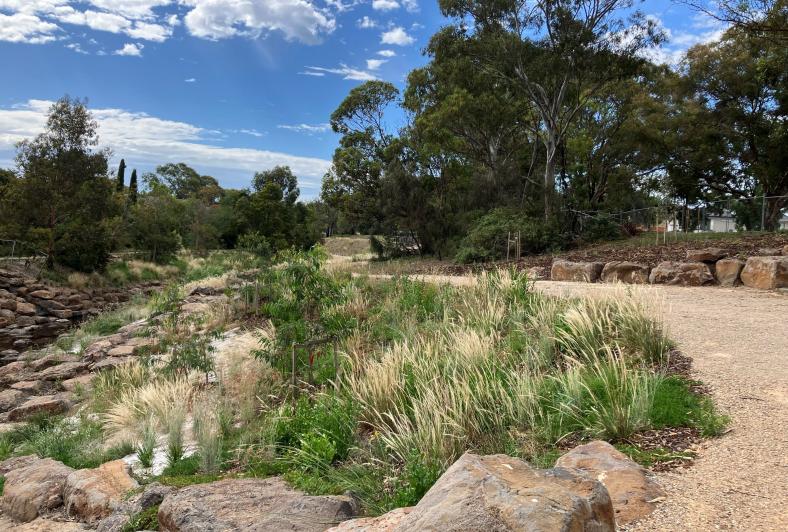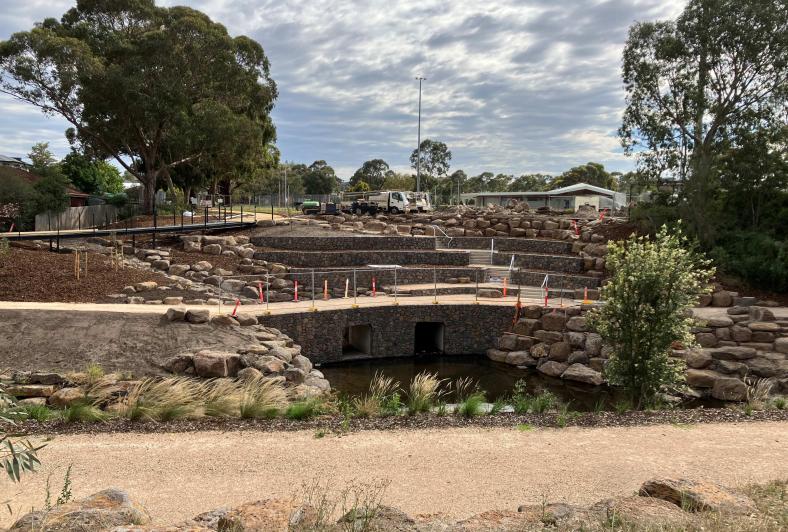We transformed a section of the Moonee Ponds Creek into a more natural and enjoyable community space.
Melbourne Water led the delivery of the project on behalf of the Chain of Ponds Collaboration Group and in partnership with Merri-bek City Council, Moonee Valley City Council, Department of Energy, Environment and Climate Action (DEECA), and Wurundjeri Woi Wurrung Cultural Heritage Aboriginal Corporation.
What we did
Naturalisation works
We transformed a 360-metre section of the concrete-lined Moonee Ponds Creek in Strathmore and Oak Park into a more natural, enjoyable community space. We did this by:
- removing the concrete walls along both sides of the creek and replacing this with rockwork
- covering the concrete base of the channel with rockwork to create a meandering creek, to slow down flows and give it a more ‘natural’ look and feel
- planting 43,000 native trees and shrubs
- creating new shared paths and a new bridge
- constructing a pond and terracing near Oak Park Reserve.
The re-naturalisation works have resulted in:
- a more appealing creek-side environment where people can interact with nature in a cooler, healthier environment
- improved water quality and waterway health by slowing water flows
- improved biodiversity and habitat for native species
- activation of open space and better active transport connections for improved community use and recreation in the area.
Cultural immersive trail - Wilami Wunmabil Trail
A Wurundjeri-led experiential trail - called the Wilami Wunmabil Trail in Woi-wurrung language - was also created along this section of creek. The unique trail highlights the cultural and natural values of the waterway, and celebrates Moonee Ponds Creek as a place owned, lived in and celebrated by Wurundjeri people. Using a mix of signage, art and digital media, the cultural elements invite the community and trail users to learn from Elders and knowledge holders about aspects of Wurundjeri culture and history, and encourages people to become better connected and care for Country. The trail is proudly supported by the Victorian Government’s Port Phillip Bay Fund that supports self-determination for Traditional Owners.
Read how the project was developed
A newly transformed space - now yours to enjoy!
We’re pleased to announce that the project area is now open and ready for you to enjoy! We’ve already noticed ducks, cormorants and other wildlife enjoying the space and making their home here, which is wonderful to see.
In the newly transformed space, we upgraded the Moonee Ponds Creek Trail which was widened and replaced with concrete, and relocated away from the waterway. We created a gravel path next to the creek for people who like to wander at a slower pace and enjoy the sights and sounds of the flowing creek.
We planted thousands of grasses, sedges, trees and shrubs, which are establishing well.
We invite you to explore the stepping stone crossing to hop over to the other side of the creek and perhaps spot some insects, water bugs, ducks and other birds along the way. Or you can use the new, wider bridge to venture to the other side.
Take a walk across the boardwalk on the Oak Park side of the creek, meet up with friends and family at the amphitheatre, and peer down at the pond below. It's an exciting space and we can't wait for you to explore it!
Caring for the environment
Keeping the area clean is important for protecting the delicate ecosystems and making it enjoyable for everyone. Please be sure to keep to the designated paths and stepping stones. These paths allow you to explore safely without disturbing the plants and animals.
Please remember to pick up after your dog and dispose of waste responsibly. And to help look after our local wildlife, please keep your dog on a leash while enjoying the new space.
Thank you
The Reimagining Moonee Ponds Creek Project Team would like to thank you for your patience, understanding and cooperation through the impacts of construction as we ‘reimagined’ this space.
FAQs
- Why was the creek lined with concrete?
-
Between the 1940s and 1980s, like many urban waterways, the Moonee Ponds Creek from Strathmore to Flemington Road was highly modified, realigned and concreted by the Melbourne and Metropolitan Board of Works (MMBW), to carry flood water away from properties in the most efficient manner possible – which was considered best practice at the time.
Waterway management and drainage approaches have evolved over time to better recognise the environmental and social value of natural waterways, and for these values to be managed in harmony with the drainage services they also provide. Current thinking now better recognises the value that restoring previously engineered stormwater channels to more natural systems (creek naturalisation) contributes to liveable communities and waterway health.
- Why was this section of Moonee Ponds Creek chosen as the site to ‘reimagine’?
-
The Reimagining Moonee Ponds Creek project covers a 360-metre section of the most northerly concreted section of the creek in Oak Park and Strathmore. Through community feedback that informed the Chain of Ponds Strategic Plan in 2018, this particular section of the creek was identified as a priority area as it was the last section of the creek to be concreted, and represents the most upstream section of concrete channel.
Reimagining Your Creek Program
Melbourne Water’s Reimagining Your Creek Program works collaboratively with councils, communities, Traditional Owners and local residents to transform stormwater drains and concrete channels into natural waterways and desirable open spaces.
The program has seen the transformation of sections of Taralla Creek in Croydon, Arnolds Creek in Melton West, and Blind Creek in Boronia, Wantirna South and Knoxfield.
Comprehensive flood modelling is always undertaken to ensure that there will be no increased flooding risk to the local community or downstream users as a result of these projects.
Community bulletins
Contact us
If you have questions or feedback on the project, please get in touch with the project team:







